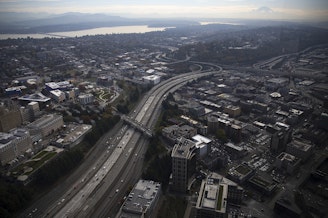How city leaders want to patch Seattle's $250 million budget deficit

Seattle is in a tricky financial position. City leaders have known for years the revenue base for the city’s general fund — largely reliant on regressive tax sources — can’t keep up with increasing costs and demand for services.
The economic climate over the past four years has only made things worse. High inflation and interest rates have decreased taxable activity in the city, notably in the construction sector. One-time funds helped keep the city solvent through the end of this year. But those funds have run out.
Now, the nine members of the Seattle City Council and Mayor Bruce Harrell are grappling with how to tackle the $250 million hole.
Sponsored
Harrell’s solution: The JumpStart Payroll Expense Tax Fund
Closing next year’s deficit with cuts alone would mean a 14% reduction to every department’s budget, according to Dan Eder, acting director of the city’s budget office.
Harrell doesn't want to make such deep cuts.
Instead, his proposal includes a number of spending changes. He outlined roughly $80 million in cuts – which include laying off 76 city workers and leaving another 80 positions unfilled – that would largely affect internal departments, like IT.
The mayor is also proposing roughly an additional $100 million in spending. The money would be targeted at public safety (overtime for police officers to do more emphasis patrols, improved lighting in some areas), responding to the opioid crisis (a new overdose recovery center slated to open next year), and keeping 300 shelter beds open as federal funding expires.
Sponsored
Harrell proposes Seattle pay for these things by using "excess" funds from the JumpStart Payroll Expense Tax Fund — a tax passed in 2020 that's intended to be used to address the affordable housing crisis in Seattle.
JumpStart taxes large employers based on the number of high-earning employees they have in Seattle. Revenue from the JumpStart tax is earmarked for affordable and low-income housing, equitable development, Seattle’s Green New Deal program, and — after City Council action earlier this year — mental health services.
Since it was passed, the tax has raised roughly double the amount of money originally predicted. The Council has used the additional dollars to fill budget deficits for the past few years.
RELATED: Mayor Harrell wants to triple Seattle's spending on opioid treatment
Under the mayor’s proposal, $233 million raised by JumpStart would go towards the programs it was created to support, while roughly $277 million would go to the city's general fund — the money that runs most of the city’s departments.
Sponsored
Councilmember Dan Strauss, one of the four co-sponsors of the JumpStart tax, was supportive of Harrell’s approach.
"Making sure that those programs receive dedicated funding from JumpStart remains a priority of mine,” he said. “Since original passage, we've had a few different changes, and I think it's time to come back and make a solid choice for a sustainable future.”
How did we get here?
According to the Institute on Tax and Economic Policy, Washington state has one of the most regressive tax systems in the country. This means lower-income people pay more in taxes, proportionally, than in other states. It also means tax revenues grow more slowly.
Seattle’s general fund gets its revenue from three main sources: sales tax, property tax, and business and occupation taxes.
These sources have not kept up with the steep inflation and sharp population growth of the past five years, said Jan Duras, the interim director of the city’s Office of Economic and Revenue Forecasting.
RELATED: Recovery from cyberattack costs Seattle Public Library over $1 million
Take property tax: "Essentially, the state law says that how much money the city can collect in property tax is determined by whatever it collected last year, plus [a] 1% increase, and plus the new construction that has been added," Duras said.
This limit doesn't include voter-approved housing levies that fund specific projects, like schools, transportation, or housing.
Sponsored
When Seattle was booming, new construction allowed the city to take in more than that 1% limit. But high interest rates and a shift away from in-person office work has halted construction across the region.
Adjusted for those factors, revenue from property taxes has dropped 25% since 2002. Similar issues of scale arise for sales tax, also impacted by the current economic environment. The city has been aware of this structural revenue challenge since at least 2019.
The path forward
The mayor's proposal to solve deficits in 2025 and 2026 with JumpStart money is not without controversy. A group of 35 service providers – many in affordable housing – released a statement criticizing the mayor's proposal.
"The need for all these investments has grown significantly since the tax was first implemented, and the need for strong city infrastructure and resources is needed now more than ever," the group said. "This structural shortfall requires a structural solution, not stopgap measures that will simply kick the problem another year down the road."
Two years ago, the city convened a Revenue Stabilization Work Group. The slate of civic, labor, and business leaders came up with ten possible ways for the city to address its structural revenue challenges by implementing new taxes. None of the suggestions have been implemented, although current and former city council members have expressed interest.
RELATED: Seattle Public Schools cancels closure meetings, is revisiting plan
Some of the new taxes would require significant legal work, including lobbying for changes to state laws. Harrell noted this challenge in his presentation of his budget, which he touted as including "no new taxes."
Other suggestions, including an expansion of JumpStart and a city-level capital gains tax, could be implemented unilaterally by the City Council.
The mayor did not need to implement any new revenue streams to offer a balanced budget through the end of 2026. But without structural changes, the city’s revenue challenge could return in force after that year.





